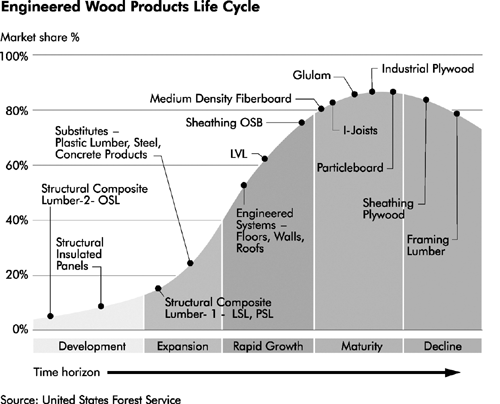
Surveys
Awards
DJC.COM
March 23, 2006
Engineered lumber makers step it up
APA
The family of structural engineered wood products is expecting new additions in the coming years. And like any family, these new siblings will likely affect the health and welfare of the current product lines in very fundamental ways.
The engineered wood family consists of four umbrella categories:
Engineered wood products have enjoyed wide acceptance and phenomenal growth because of their better quality, better performance and greater predictability than sawn lumber and timbers.
Back in the late 1980s, when public and private lands were locked up to save endangered species, fear swept through the industry that timbers and wide lumber would be hard to find.
Builders were surveyed on whether they would use engineered wood in place of sawn timber even if it meant paying a premium. Their response was favorable. They said they would do so if engineered wood was stronger, had little variability from piece to piece, offered little or no waste and reduced callbacks. And once they adopted engineered wood, most builders remained loyal converts.
Engineered wood is uniform — no knots, warping, cupping or other problems associated with dimension lumber.
I-joists are a classic illustration of the economies of increased strength and performance made possible with engineered wood. When used at the conventional lumber spacing of 16 inches on center in a typical floor, I-joists use 36 percent less wood fiber than solid sawn lumber. When spaced at 19.2 inches on center, I-joists use 46 percent less wood fiber than lumber.
Even though engineered wood costs more per piece, it takes fewer pieces to build a house and thus is a far more efficient use of a natural resource.
What's hot, what's not
It's popular to attempt to put engineered wood into a product life-cycle graph like those used in marketing 101 courses. For example, plywood's reign as sheathing king ended in 1999, when OSB production exceeded plywood production. Along with softwood framing lumber, plywood is considered mature and on the decline. Other products, like glulam beams and OSB sheathing, are mature or nearing maturity.
I-joists may have moved into the mature status as well. I-joists enjoy a 40 percent market share of wood floors in the United States and Canada. Last year, even though I-joist market share and volume declined, production was 1.26 billion linear feet. That's enough to stretch 240,000 miles from the earth to the moon.
Demand for LVL also took off with I-joists because LVL was primarily used for I-joist flanges. Now, only about 40 percent of LVL production is used in I-joists. The rest is used for beams, headers and rim boards in I-joist floor construction. The growth of LVL beams and headers has been the reason for LVL's spectacular growth in the past five years. LVL appears to still be on the growth curve.
The second generation of structural composite lumber products, OSL and SPSL, is recognized by the International Code Council. Neither product is on the market today, but they soon will be. They are placed on the lower end of the life-cycle curve because they are still in development, ready to experience their expansion and rapid growth phases.
OSL will likely become a beam and header product that will take share away from many of the products already in the market, including solid sawn lumber glulam and LVL.
Room for growth
Another way to look at the future of engineered wood is to focus on the total volume of structural lumber and engineered wood used today in North America. Twenty-five years ago, engineered wood was less than 1 percent of the combined total of structural lumber and engineered wood. Engineered wood was mostly glulam, I-joists and LVL. Most of the LVL was used in I-joists.
By 1990, engineered wood had grown to over 55 million cubic feet and represented 1.7 percent of structural lumber products. For this analysis, we've subtracted the volume of LVL used in I-joists to avoid double counting in the engineered wood numbers.
In 2005, we estimate that engineered wood has grown to nearly 6 percent of structural lumber products, over 250 million cubic feet. 2005 was an exceptional demand year for wood products and lumber consumption increased to over 4 billion cubic feet.
The forecast to 2012 assumes that some combination of engineered wood products will continue to displace structural lumber. We're not sure what the exact combination of engineered wood products will be. For example, I-joists and LVL could become mature and a new generation of composite lumber products could have a growth spurt.
Our forecast also includes a decline in sawn lumber demand to the 4 billion cubic foot level as engineered wood products continue to grow.
Forest facts
One-third of the United States land base — 731 million acres — is covered by forests. In Canada, half of the land base is forested. Every year American landowners plant more than 2 billion trees. This high rate of replanting in both countries accounts for the fact that each year 27 percent more timber is grown than is harvested.
Wood, in both its dimension form and as an engineered product, will continue to serve our needs as a structural building material for a long time.

Image courtesy APA
|
Craig Adair is director of market research at APA--The Engineered Wood Association, a nonprofit group whose members produce a variety of engineered wood products.
Other Stories:
- A bright outlook for local construction
- See through walls to find water leaks
- How much do you know about forklift safety?
- Are you communicating clearly? Your bottom line is at stake
- Sound Transit digs a cutting-edge tunnel
- Need a tower crane? Take a number
- It only takes a minute — to get hurt
- Get a handle on escalating costs
- Joint ventures are like marriages — know your partner
- Scoccolo case could hurt contractors, taxpayers
Copyright ©2009 Seattle Daily Journal and DJC.COM.
Comments? Questions? Contact us.